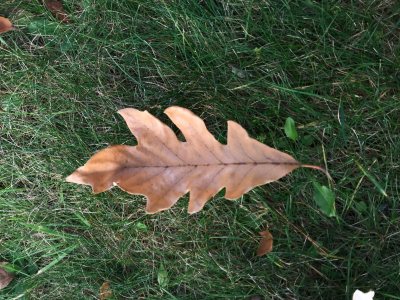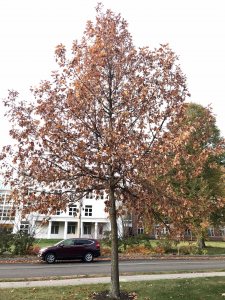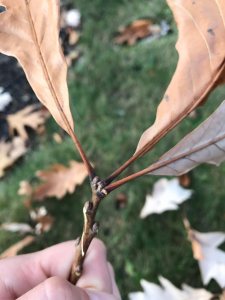White Oak
Quercus alba | Family: Fagaceae
Submission: Danielle Ward ‘20
The white oak (Quercus alba) is a perennial tree of the Fagaceae family that best grows on rich, heavy, upland soil at a relatively slow growth rate of 12” to 24” every year. It is a medium to tall tree, capable of reaching heights of 60-70’ and a diameter of 3-4’. This species grows in a round or oval shape, is moderately tolerant to shade, and establishes a deep taproot system. The leaves of the white oak turn shades of red or burgundy in the fall and the dead leaves are often marcescent over the winter, meaning they are not shed. The native range of this tree extends across the eastern United States and Canada.
The white oak belongs to the subgenera of white oaks, which are characterized by several attributes, including leaves with lobes that lack bristle tips, fruit that matures in one season, and a range that extends throughout the Northern Hemisphere. Additionally, the white oaks’ wood has tyolses, which are unique balloon-like structures that protect damaged vascular conduits.
 Over the course of American history, the white oak has been deeply rooted in the lives of people. Beginning in the pre-colonial era, Native Americans used the tree for flour by bleaching out the tannin and pounding it into a fine consistency. In 1797, the naval ship, the USS Constitution, was built using white oak. While it was in service during the War of 1812, the ship earned the nickname, “Old Ironsides,” due to its incredibly durable hull. It is said to have not been impacted by cannons shot at its sides, even during the most furious of engagements.
Over the course of American history, the white oak has been deeply rooted in the lives of people. Beginning in the pre-colonial era, Native Americans used the tree for flour by bleaching out the tannin and pounding it into a fine consistency. In 1797, the naval ship, the USS Constitution, was built using white oak. While it was in service during the War of 1812, the ship earned the nickname, “Old Ironsides,” due to its incredibly durable hull. It is said to have not been impacted by cannons shot at its sides, even during the most furious of engagements.
Although its wood has long since been used for naval shipbuilding, the white oak is still commonly harvested to be used for flooring, furniture, and boatbuilding. The presence of tyloses in the wood itself makes it preferable for wine and whiskey barrels, as well as for wooden boats.
The white oak is equally important for wildlife species as it is for humans. The acorns it produces are a primary source of nutrition for many birds, deer, and rodents. The twigs and foliage are also a popular food source for deer, especially in areas that are not heavily forested.
Leaves – usually nine-lobed, rounded, slightly cleft or cleft nearly to the midrib, alternate, 4-7” long, bright green above, pale green or whitish beneath.
Twigs and Buds – twigs are gray to purple; buds are blunt-pointed, and scales are without hairs.
Fruit/Cone – the acorn is about ¾” long, 2-4 times longer than the cup, and about one quarter enclosed by it.
Bark – separated into thin, irregular flakes and varies from light to ashy-gray.
References:
Arbor Day Foundation. c2015. White Oak Quercus alba. [accessed 2017 Oct 26]. http://www.arborday.org/trees/treeguide/TreeDetail.cfm?ItemID=883.
Encyclopedia Britannica. 2016. Organization of the vascular tissue. [accessed 2017 Oct 26]. https://www.britannica.com/plant/angiosperm/Organization-of-the-vascular-tissue#ref596788.
Forest Trees of Maine. Fourteenth edition. Maine Forest Service; 2008.
This Day in History. 2010. A+E Networks; [accessed 2017 Oct 26]. http://www.history.com/this-day-in-history/old-ironsides-earns-its-name.
USDA Natural Resources Conservation Science. Quercus alba L. white oak. [accessed 2017 Oct 26]. https://plants.usda.gov/core/profile?symbol=QUAL.

